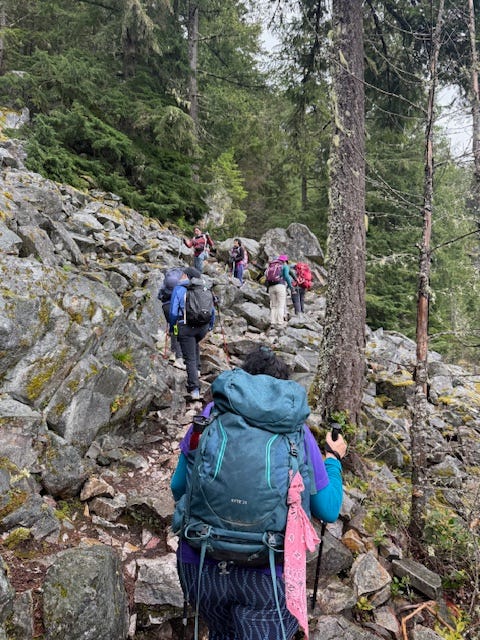Trust
At a young age, the perils of offshore fishing taught me a leader’s most important job: Earning and building trust.
My classroom was a 75-foot steel lobster boat operating more than 100 miles offshore. From age eleven to twenty-one, I spent summers in this high consequence lab for human behavior.
When I began working on boats, I had a recurring bad dream. In essence, the dream went like this:
I’m standing on the deck as the boat cuts through dark green seas at dusk. I steady myself as the boat rolls with large swells.
I’m alone. After fourteen hours of work, the crew rests in the cabin before dinner.
I’m guiding the last set of lobster pots into the ocean. They slide across the deck one by one, connected by heavy braided rope. They’re carefully stacked to ensure they glide off smoothly.
The accident happens quickly.
A tangle of rope and wood flies across the deck out of sequence. They catch my leg and knock me off balance. I stumble, try to right myself and fall backwards into the ocean.
In seconds, my world changes dramatically. The water is cold. Salt stings my eyes. I thrash, swallowing ocean water.
The boat serenely steams into the distance as the sun dips below the horizon, the crew oblivious to my dilemma. I’m an inconsequential speck bobbing in a vast indifferent ocean.
Miles from land or help, I tread water. Yelling is pointless. I’m alone a hundred miles offshore.
I dreamed variations on this scenario. A crew member falls asleep while on watch and the boat collides with a tanker. A mechanical failure causes the boat to rapidly take on water.
Fortunately, my fears never materialized due to strong leadership, teamwork and culture.
We tied knots and stacked pots correctly. We performed late night watches diligently. We serviced equipment with care. We scrubbed the deck until it was immaculate. We performed every aspect of our jobs competently.
More than that, we cared about each other. We knew each other’s families. We held each other accountable. We lent a hand when a crewmate needed help. It started with our captain, my Uncle Bruce, who modeled competency, hard work and integrity.
Without trust, teams can’t do their best work and organizations can’t perform consistently. In high stakes environments like offshore fishing, trust is the difference between life and death.
Trust enables speed. Trust fuels innovation. Trust spurs creativity. Trust unleashes talent. Trust creates joy. Trust powers high performance.
I’ve experienced high trust environments in sports and on mountains, in large organizations and in boardrooms, on offshore fishing boats and at small non-profits. I experienced it at 16,000 feet on Mt. Kilimanjaro. I saw it as an elite runner in college. I saw it this summer when I helped train a group of cancer survivors to summit Camp Muir.
I also have seen countless examples of leaders breaking or eroding trust and the toxic effect this has on teams and organizations.
Great leaders purposely create conditions for trust to exist. Today, I share my experiences working with leaders who create trust.
The Basics
The foundation of trust is doing what we say we’re going to do, consistently.
The crew I worked with those summers on the Atlantic did good work consistently. This enabled us to put our lives in each other’s hands in dangerous situations.
The best brands show the same trait. Alaska Airlines takes off and lands on time and delivers bags intact at a higher rate than most competitors. They do thousands of things every day to make that come true across people, process and technology.
Nordstrom consistently provides great service. Amazon delivers orders on time repeatedly. Like Alaska, Nordstrom and Amazon, brands that earn trust deliver consistently. Apple. Costco. Google. Intuit. Pixar. Home Depot.
This applies to leaders as well. We need to do routine things well, repeatedly.
Follow through on commitments. Be on time. Stay within budget. Respond to emails. Keep 1:1s with team members. Deliver on what we promise to customers, partners and teams consistently and dependably.
By doing this, leaders lay the foundation for trust.
Transparent, Caring, Human
I stood in front of 60 mechanics, flight attendants, gate agents, technicians and pilots. They had flown in from all over the country.
We discussed strategy. We discussed the company’s financials in detail. We discussed the importance of being lean and efficient. We discussed the risks we faced. We fielded difficult questions. We had an honest discussion. We did this every day all summer.
It was one of the greatest examples I’ve seen of transparency. Those candid discussions created trust across 10,000 employees at a large airline. They powered the airline to financial success, operational excellence and numerous customer experience awards.
Similarly, at one point I supported the Chief People Officer at a global tech company that was struggling with silo’s, low morale and attrition. During her first week on the job, she kicked off a listening tour. She traveled around the world, meeting thousands of employees.
She took on every question, many of them tough. She answered candidly. She acknowledged problems. She committed to addressing employee concerns about benefits, compensation, career mobility and work-life balance. Room by room, she built trust. Slowly she turned the tide.
When I reflect on the best leaders I’ve seen in my career, they follow these patterns. Consistent. Dependable. Humble. Transparent. Vulnerable. Over long periods of time.
Those summers far offshore stay with me to this day. Working in a high consequence environment left me with a powerful understanding of trust.
We can unleash our teams and organizations by applying these lessons every day, one interaction at a time. In that way, we can unlock potential, enable innovation, spur creativity, empower teams and better serve customers.
It begins with trust.

